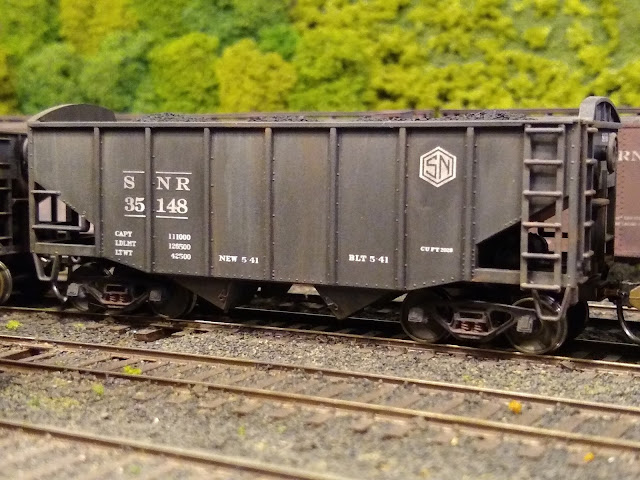Like most coal roads, most of the new hoppers purchased by the SNR since WWII have been 70-ton 3-bays. However the vast fleet of 50-55 ton cars is continuously being overhauled in order to serve smaller retail customers, and producers located on light-duty branch lines.
Since the turn of the century the rib-side had been the standard hopper design, the higher-capacity offset-side gained favor in the late 1930s, and is now the standard design for new cars.
Major orders for new hoppers have traditionally received numbers in the 3xxxx range, and with the change to 70-ton cars, the 4xxxx range. However the chaos of WWII, with used car purchases and war-emergency cars constructed in rare small batches, as well as integrating subsidiaries' equipment into the fleet, has left no corner of the number line untouched by hoppers. As they say, no battle plan survives the first shot.
Here's a sampling of some of the most common classes in the hopper fleet.
Material shortages during WWII made new cars difficult to acquire, so virtually the entire class of these cars was treated to a repair and painting program in the early 1940s to extend their lives. However, with labor also in short supply, cars painted during the war received a "just the facts, ma'am" scheme which omitted the roadname.
These older, shorter cars are commonly referred to as "buggies" by SNR men.
In the later 1920s, a slightly longer rib-side design replaced the fishbelly, with a 55-ton nominal capacity that became the standard for twins. Like the fishbellies, most of these cars were restored during WWII, receiving the "no-name" bare-bones paint scheme.
However, being slightly newer, not all of the class turned out to be in need of overhaul during that period. Therefore some cars were not painted until post-war, and so sport the full roadname.
A few of this class even have managed to eluded the paint shop altogether, and can be found still dressed in their original pre-1936 scheme, with the old herald, non-AAR reporting marks, and still using "Railway" in the roadname.
Starting in 1936, the SNR began purchasing most of its new cars in the "offset-side" design - just in time for the new paint scheme, sans "Railway" and with the new "hex" herald. Being nearly new at the outbreak of hostilities, very few of these cars were overhauled during the war, and so the "no name" scheme is almost non-existent on them. After the war, the railway resumed purchasing new twin hoppers of this design, gradually switching to the 70-ton triple by the late 1940s.
Material and labor shortages during WWII meant that the only new cars that could be built had to be of a composite design, with wood being used in the side panels to save on steel. With new equipment being catch-as-catch can, these cars were acquired mostly in small batches wherever and whenever they could be found. Therefore there are marked dissimilarities within the class as to lettering locations, sizes, fonts, etc., which makes spotting them a sport. The common theme however is the war-baby "no-name, no-nonsense" paint scheme.
Since the war, some cars with the most-deteriorated wooden components have begun to have the wood replaced with sheet steel in the side panels. They retain their original structure, however, including that iconic Z-bracing.
As the 1940s rolled on, the 70-ton hopper and higher-capacity trucks became a settled design, and found favor in a 3-bay format, versus twins and quads. To date, the SNR has received 3 major orders of offset 3-bay cars, the first arriving in 1947, which became the 41xxx series, and reached into the 44000's.
A second order in 1949 received the new, larger "hex" herald, and became the 45xxx and 46xxx series.
A number of cars from subsidiary Cincinnati Jackson & Gallipolis can also be seen circulating freely within the fleet. The CJ&G is still the legal owner of the west end of the SNR, connecting that road's namesake cities, and for tax and legal reasons some equipment is still lettered for it, as it is for other predecessor roads. However, operationally the fleet is treated as homogeneous. CJ&G cars are as likely to be seen serving producers on the Suffolk Northern proper, as SNR cars are to be seen serving mines on the Apple Hill Road in southeastern Ohio.












No comments:
Post a Comment